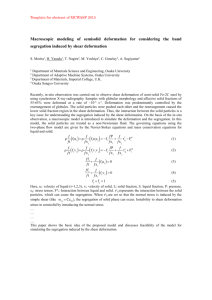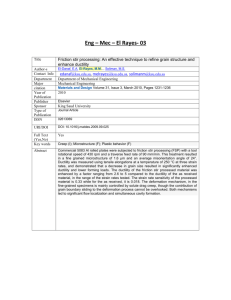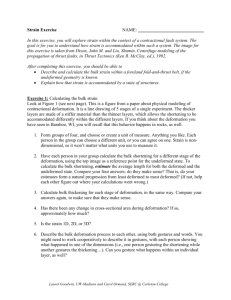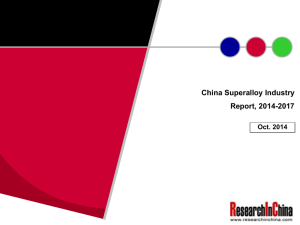Paper
advertisement
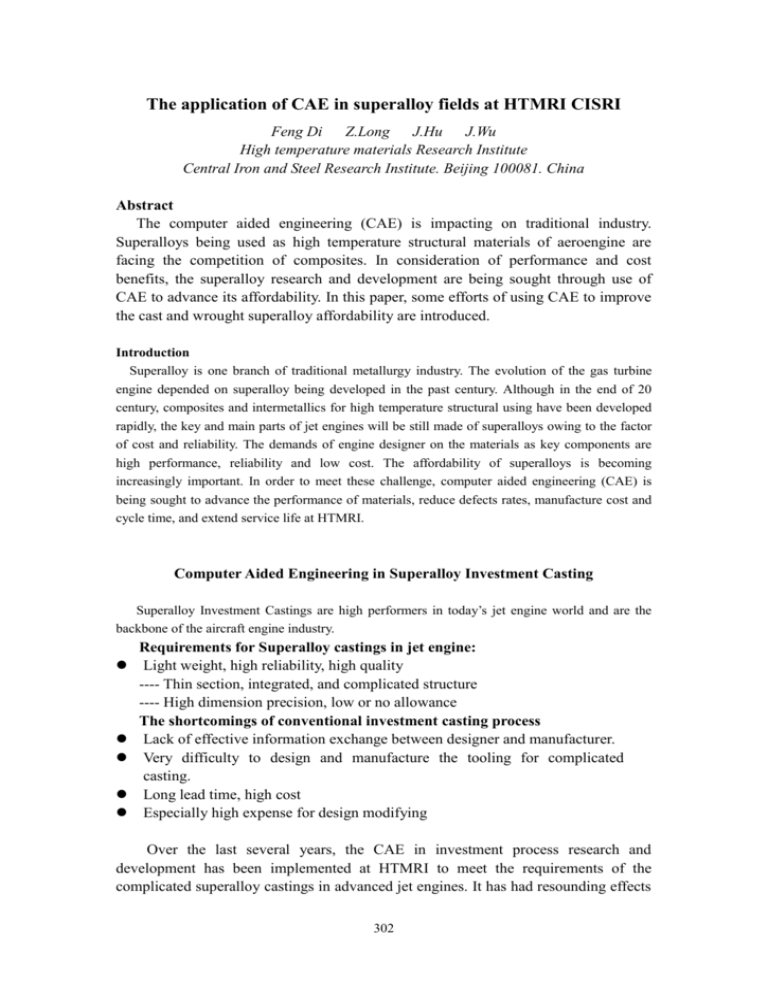
The application of CAE in superalloy fields at HTMRI CISRI
Feng Di Z.Long J.Hu J.Wu
High temperature materials Research Institute
Central Iron and Steel Research Institute. Beijing 100081. China
Abstract
The computer aided engineering (CAE) is impacting on traditional industry.
Superalloys being used as high temperature structural materials of aeroengine are
facing the competition of composites. In consideration of performance and cost
benefits, the superalloy research and development are being sought through use of
CAE to advance its affordability. In this paper, some efforts of using CAE to improve
the cast and wrought superalloy affordability are introduced.
Introduction
Superalloy is one branch of traditional metallurgy industry. The evolution of the gas turbine
engine depended on superalloy being developed in the past century. Although in the end of 20
century, composites and intermetallics for high temperature structural using have been developed
rapidly, the key and main parts of jet engines will be still made of superalloys owing to the factor
of cost and reliability. The demands of engine designer on the materials as key components are
high performance, reliability and low cost. The affordability of superalloys is becoming
increasingly important. In order to meet these challenge, computer aided engineering (CAE) is
being sought to advance the performance of materials, reduce defects rates, manufacture cost and
cycle time, and extend service life at HTMRI.
Computer Aided Engineering in Superalloy Investment Casting
Superalloy Investment Castings are high performers in today’s jet engine world and are the
backbone of the aircraft engine industry.
Requirements for Superalloy castings in jet engine:
Light weight, high reliability, high quality
---- Thin section, integrated, and complicated structure
---- High dimension precision, low or no allowance
The shortcomings of conventional investment casting process
Lack of effective information exchange between designer and manufacturer.
Very difficulty to design and manufacture the tooling for complicated
casting.
Long lead time, high cost
Especially high expense for design modifying
Over the last several years, the CAE in investment process research and
development has been implemented at HTMRI to meet the requirements of the
complicated superalloy castings in advanced jet engines. It has had resounding effects
302
on key aspects of producing a complicated casting.
The flowchart of complicated casting development is follows and an example
of CA Invest casting is presented in Fig.1:
Casting 3D solid modeling
Pouring system Design
Process and Parameters
Modification
STL file
Rapid Prototy ping
Wax pattern
NDT
Shell making
Casting process,solidification
and cooling simulation
thermal stress analysis,
macroporosity and defects
Predication
(1) 3-D solid modeling
Fig 1
RP mold
Pouring
(2) wax pattern
Products
HIP
Casting
(3) pouring assemble
(4) casting
An example of CA investment casting
At first, the teamwork of “design-material-process” has been realized through
using CAE in conventional investment cast process. The engine designer, materials
researcher and castings engineer are working together, to discuss and solve the
demands from designer, the performance of materials and the process of casting
through electronic data. The 3-D computer aided design software are used. The
transfer of the data into real components is being achieved through electronic data. A
rapid prototyping pattern is used directly as investment pattern in shell making for
complicated castings. It is very simple to change design pattern produced from
electronic data, but much more difficult to modify hard tooling. The lead-time is
shortened significantly, and the cost is reduced.
The traditional investment casting process is not suitable to the new demand of
aeroengine complicated castings.
Computer aided engineering has had a significant impact on superalloy
investment casting. The impact not only reduced lead time and cost, but also
promoted a new teamwork mode and created an opportunity for engine designer to
303
design more complicated casting that never be imagined.
The Hot Deformation Modeling of As-Cast Highly Strengthened Superalloys
The ingot conversion process is a key processing step in forging process
especially for large diameter superalloy ingot and the highly strengthened superalloys
such as GH742, Udimet 720 etc. which are widely used in new generation jet and land
base power engines.
Highly strengthened superalloys have less hot workability caused by high level
of alloying elements and
’ precipitating phase which induce the element
segregation and metallurgy defects. Additionally, the hot workability is very sensitive
to hot deformation parameters. In conventional manufacturing routes, numerous trial
and error steps must be taken to achieve the suitable processing parameters.
Therefore, it is very useful to develop an effective model to predict deformation
behaviors.
Alloy GH742 is used as sample to study the hot workability of highly
strengthened superalloys. First, the material database was set up using compression
tests with deformation temperature from 1050 to1125℃, engineering strain from 0.1
to 0.7; and the true strain rates of 0.1, 0.01 and 0.001S-1. The microstructure of
deformed samples was examined by optical and electrical microscope.
Empirical metallurgical equations were developed to describe the relationship
between flow stress deformation ductility, dynamic recrystallization(DRX) and
deformation parameters. The equations should not only describe the experimental
results very well, but also reflect the phenomena occurring during hot deformation.
.
These equations and simulated results are as follows
(1) The peak flow stress vs. parameters
Fig.2 gives the experimental relationship of peak flow stress with deformation
temperature and true strain rate. The following is the simulated equation.
Q
A n exp
RT
where A is a constant, n is a parameter related to the true strain rate, Q is the
deformation activation energy and R is the gas constant.
The above equation shows that ln
and ln ,lnQ and lnT have a linear
relationship as same as the experimental results of Fig.2. Therefore, the parameter n,
Q and A can be obtained from Fig. 2. N=0.159 Q=2177564.11 A=1.824. Fig.3
shows the simulated results, it predicts the experimental results very well.
304
6.2
6.2
6.0
5.8
5.6
ln(¦Ò)
5.4
C
1060
C
1080
5.8
C
1100
5.4
5.2
1120
C
5.0
4.8
1140
C
5.6
ln(¦Ò)
6.0
5.2
4.4
4.4
4.2
4.2
-3.45
-2.30
1s
0.00
4.0
0.00070
4.0
-4.60
-1
4.8
4.6
-5.75
-1
s
0.01
5.0
4.6
-6.90
-1
s
0.1
-1.15
0.00072
ln(¦Å)
0.00074
0.00076
1/T (1/C)
Fig. 2 The relationship of peak flow stress with deformation temperature and true strain rate.
300
250
200
150
300
250
200
150
100
1E-3
1060
50
1080
1100
Te m
per
1120
atu
)
0.01
re (
1140
¡æ
)
ra
0.1
u
Tr
t
eS
in
Ra
te
1060
/s
(1
1080
0.01
1100
T em
pera
1120
ture
(¡æ
1140
0.1
)
ue
ra
St
in
Ra
te
100
1E-3
50
/s)
(1
True stress (MPa)
350
Pa)
400
350
True Stress (M
450
400
Tr
(a) experimental results
(b) calculated results
Fig 3. The experimental and calculated peak flow stress
(2) Hot defamation ductility vs. parameters
Simulated equation:
T1 T
δ A( )
1
exp
f ( )
1
T T2
1
exp
f ( )
2
The effects of true strain rate on the ductility are reflected in parameters A,f1, and
f2. The equations obtained by statistical fit are as follows:
A( ) 133.83 1179.14 exp( / 0.0113)
f 1 ( ) 150.16 38.55 exp( / 0.0169)
f 2 ( ) 86.29 180.43 exp( / 0.0181)
Fig.4 shows the calculated and experimental hot deformation ductility. It is seen
that the model predicted the hot deformation ductility very well.
305
60
60
50
50
Ductility (%)
30
20
40
30
1180
1160
1140
1120
1E-3
True
(C
)
Te
m
pe
ra
tu
re
(C
0
1E-3
1100
0.01
Stra
in Ra
te (1
/s)
1080
0.1
1180
1160
1140
1120
20
)
10
True
1060
1100
0.01
Stra
in Ra
te (1
/s)
Te
m
pe
ra
tu
re
Ductility (%)
40
1080
0.1
1060
(a) experimental results
(b) caculated results
Fig.4 The experimental and calculated hot deformation ductility
(3) Percent dynamic recystallization (DRX) vs. parameters
Simulated equation:
DRX 50 31.831 a tan( p1 ( 50 ))
where P1 is the slope rate that describes the gradient of cures and ε50 is the critical
strain which indicates 50% DRX occurred during hot deformation.
The equations obtained by statistical fit of experimental data.
P1 = 27.60691-0.05203×T+2.46E5×T2
2
50 = 6291.5-10.46586×T+0.00436×T
Fig.5 presents the calculated and experimental percent dynamic recrystallization,
it shows the equations describe the relationship between percent DRX and
deformation parameters very well.
100
100
80
20
10
1180
1200
0
re
(%
tu
40
ra
10
20
30
Eng.
Stra
in (%
)
)
æ)
1160
in
20
1140
.S
1120
ture
(¡
1200
1175
1150
1125
1100
1075
1050
(¡æ
00
En
g
0
1060
1080
1100
60
50
40
30
50
pe
20
Tem
pera
40
)
40
60
60
Te
m
DRX £¨%£©
60
tra
DRX £¨%£©
80
(a) experimental results
(b)calculated results
Fig.5 The experimental and calculated percent DRX
Constitutive Equation Model of Superalloy Inconel 718 for High Speed
Counter-blow Hammer Forging
306
Inconel 718 has been most widely used as turbine discs because of its good
performance and low cost. However, it is difficult to control microstructure of forging
during deformation processing because of complicated phase composition.
In the past decade, some numerical models were set up to predict the
microstructure evolution during deformation. Most of them were based on isothermal
constant speed pancake forging process.
For economical view, high-speed counter-blow hammer forging is widely
adopted because of very efficiency. Therefore, our work focuses on the simulation of
high-speed multi-pass deformation process, the investigation of the deformation
behavior influenced by hot deformation parameters, and development of the
constitutive equation reflecting the flow rule of high-speed counter-blow hammer
forging process.
Experiment Method
Counter-blow hammer forging process is different to isothermal pancake forging
process, more than 30 deformation passes should be needed to get finished forging.
Within the interval time, static recovery and recrystallization will be occurred. Since
more than 70% strain should be completed in initial several passes, the 3-passes and 5
passes deformation schedule have been adopted to simulate the practice deformation
history. The distribution of engineering strain for 3 passed and 5 passes is 0.4+0.2+0.1
(0.7 in total) and 0.25+0.15+0.15+0.1+0.05 (0.7 in total) respectively. The compress
testing was carried out with High Speed Testing Machine. The testing parameters
were adopted as follows.
Deformation temp.: 960o C – 1040o C with an interval of
200
o
C.
Strain rate:10/s.
Interval times:5 second
Heating hold time: 30 min.
Simplification of the stress-strain Curve
3-passes and 5-passes true stress-true strain curves, which reflects the
thermo-mechanical history of compression specimen, are shown in Fig.6. These
curves are difficult to express in mathematics. In consideration of the same interval
time between two passes, the effect of interval time on the flow stress is constant.
Hence, the effect can be synthesized as one constant state variable. Fig.6 shows there
are work hardening and recrystallized softening in the recorded stress-strain curve as a
whole, which is similar with the stress-strain curve of conventional isothermal
constant speed forging process. Therefore, the multi-pass stress-strain curve can be
simplified and quantified as the only single pass forging process as showed in Fig.7. It
is easy to describe the stress-strain curve mathematically.
307
800
800
700
700
960¡æ
600
600
500
1040¡æ
True stress, MPa
True stress, MPa
980¡æ
400
300
200
1000¡æ
1020¡æ
1040¡æ
400
300
200
100
0
0.0
960¡æ
1000¡æ
500
100
0.2
0.4
0.6
0.8
1.0
0
0.0
1.2
0.2
0.4
Truestrain
0.6
0.8
1.0
1.2
Ture strain
Fig.6 True stress-true strain curve
700
Experimental data
Simplification curve
Ture stress, MPa
600
500
400
300
200
100
0
0.0
0.1
0.2
0.3
0.4
0.5
0.6
0.7
0.8
0.9
1.0
1.1
1.2
1.3
True strain
Fig.7 Simplification figure of multi-pass deformation true stress-strain curve (n=5)
Constitutive Equation
The relationship between the flow stress and the strain can be outlined by
following formula.
=A× n×exp(f( ))
where n is work hardening rate, A is a constant.
The relationship between the flow stress and deformation temperature can be
described as follows:
T = B0+ B1×exp[(B2-T0)/B3]
where T is deformation temperature, Bo,B1,B2 and B3 are constants.
Flow stress is the function of strain and deformation temperature, at the constant
strain rate with 10/s. The synthesized constitutive equation is as follows.
308
=A×
n×exp(f( ))×{B0+ B1×exp[(B2-T0)/B3]}
The simulation curves, which are calculated from constitutive equation, are
consistent with experiment value in Fig.8. The simplified schedule of high-speed
counter-blow hammer forging process of superalloy In718 is reasonable and feasible.
The microstructure model have been developed as follows:
D = Dmin×Fmin+ Dman×Fman
D = Co×exp(ε)×exp[C2/(Z+C3)×t×(C4+C5×t + C6×t2)]
D — the average grain size without holding process
Dmin — the recrystallization grain size
Fmin — the recrystallization fraction
Dman — the unrecrystallization grain size
Fman — the unrecrystallization fraction
D — the increment of the grain size owing to the hold process after
deformation
C0, C2, C3, C5 and C6 are constants.
800
700
True strain, MPa
600
500
400
300
960¡æ
980¡æ
1000¡æ
1020¡æ
1040¡æ
200
100
0
0.0 0.1 0.2 0.3 0.4 0.5 0.6 0.7 0.8 0.9 1.0
Engineering strain
Fig.8 Simulation results of stress-strain curve (n=5)
Fig.9 gives the typical examples of simulation results of the grain field of final
forged disc, it shows the calculated microstructure by numerical model is similar to
the actual experimental results of disc.
309
Fig.9 Simulation results of the grain field of final forged disc
Above mentioned are several examples of CAE application in superalloy casting and
deforming processes. The influence of computer modeling to simulate casting and deforming
processes is revolutionizing process development in the superalloy field. It will help improve
affordability of superalloy in the competitive market.
References
1. J.M.Zhang, L.Z.Ma, “Superalloy 718,625,706 and various Derivatives” Edited
by E.A.Loria. The Minerals, Metals and Materials Society 1997, P183-192.
2. Z.Long, J.Zhang, “Advanced Technologies for Superalloy Affordability” Edited
by K.M.Chang, S.K.Srivastava,2000. P187-196.
3. David Furrer and Hans Fecht, Ni-Based Superalloys for Turbine Discs, JOM,
January 1999,PP14-18
4. M.J.Goulette, The Future Costs Less-High Temperature Materials From an
Aeroengine Perspective, Superalloys 1996, eds., R.D.Kissinger et al.
(Warendale:TMS 1996) , PP3-6
5. D.Lasalmonie, et al., A Computer assisted Design and Modeling Tool For
Superalloy Powder Precision Modeling, Superalloys 1996, (Warendale:TMS
1996) PP737-743
6. .M. Zhang, Z.Y.Gao, J.Y.Zhuang, Q.Deng, and P.Janschek, J. Mater. Processing
Technol., 1997, vol.70, pp252-257
7. Z. Long, J.Zhuang, B.Deng, P.Lin, Z.Zong, The Hot Deforamtion Modeling of
As-Cast High-Strengthened superalloys, Advanced Technologies for Superalloy
Affordability, eds. K-M Chang, S.K.Srivastava, D.U.Furrer and K.R.Bain,
(Nashville, March TMS,1997) PP187-196.
8. Z. Long, J.Zhuang, B.Deng, P.Lin, Z.Zong, Advanced Technologies for
Superalloy Affordability, eds. K-M Chang, S.K.Srivastava, D.U.Furrer and
K.R.Bain, (Nashville, March TMS,1997) PP287-297.
9. F. Hediger and N. Hofmann. Proc.of the 5th Intern. Conference in Modeling of
Casting, Welding and advanced Solidification Processes, Davos, Switzerland,
sept. 16-21, 1990, eds, M.Rappaz et al., Warendale:TMS 1991, p.611-619.
310

